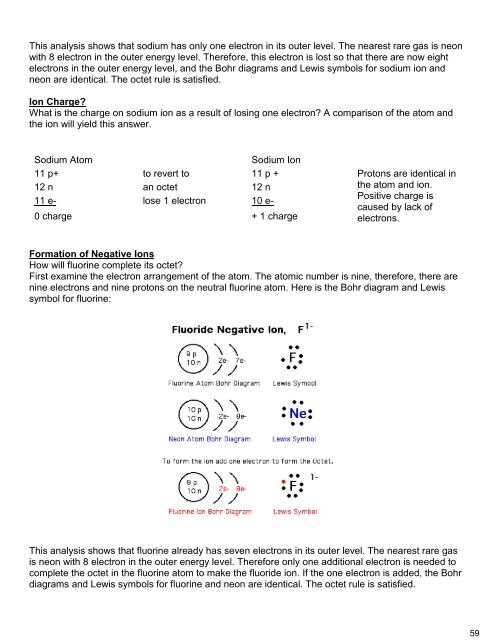(FINAL) Chemistry Notebook 2016-17
- No tags were found...
You also want an ePaper? Increase the reach of your titles
YUMPU automatically turns print PDFs into web optimized ePapers that Google loves.
This analysis shows that sodium has only one electron in its outer level. The nearest rare gas is neon<br />
with 8 electron in the outer energy level. Therefore, this electron is lost so that there are now eight<br />
electrons in the outer energy level, and the Bohr diagrams and Lewis symbols for sodium ion and<br />
neon are identical. The octet rule is satisfied.<br />
Ion Charge?<br />
What is the charge on sodium ion as a result of losing one electron? A comparison of the atom and<br />
the ion will yield this answer.<br />
Sodium Atom<br />
Sodium Ion<br />
11 p+ to revert to 11 p + Protons are identical in<br />
12 n an octet 12 n<br />
the atom and ion.<br />
Positive charge is<br />
11 e- lose 1 electron 10 e-<br />
caused by lack of<br />
0 charge + 1 charge<br />
electrons.<br />
Formation of Negative Ions<br />
How will fluorine complete its octet?<br />
First examine the electron arrangement of the atom. The atomic number is nine, therefore, there are<br />
nine electrons and nine protons on the neutral fluorine atom. Here is the Bohr diagram and Lewis<br />
symbol for fluorine:<br />
This analysis shows that fluorine already has seven electrons in its outer level. The nearest rare gas<br />
is neon with 8 electron in the outer energy level. Therefore only one additional electron is needed to<br />
complete the octet in the fluorine atom to make the fluoride ion. If the one electron is added, the Bohr<br />
diagrams and Lewis symbols for fluorine and neon are identical. The octet rule is satisfied.<br />
59





